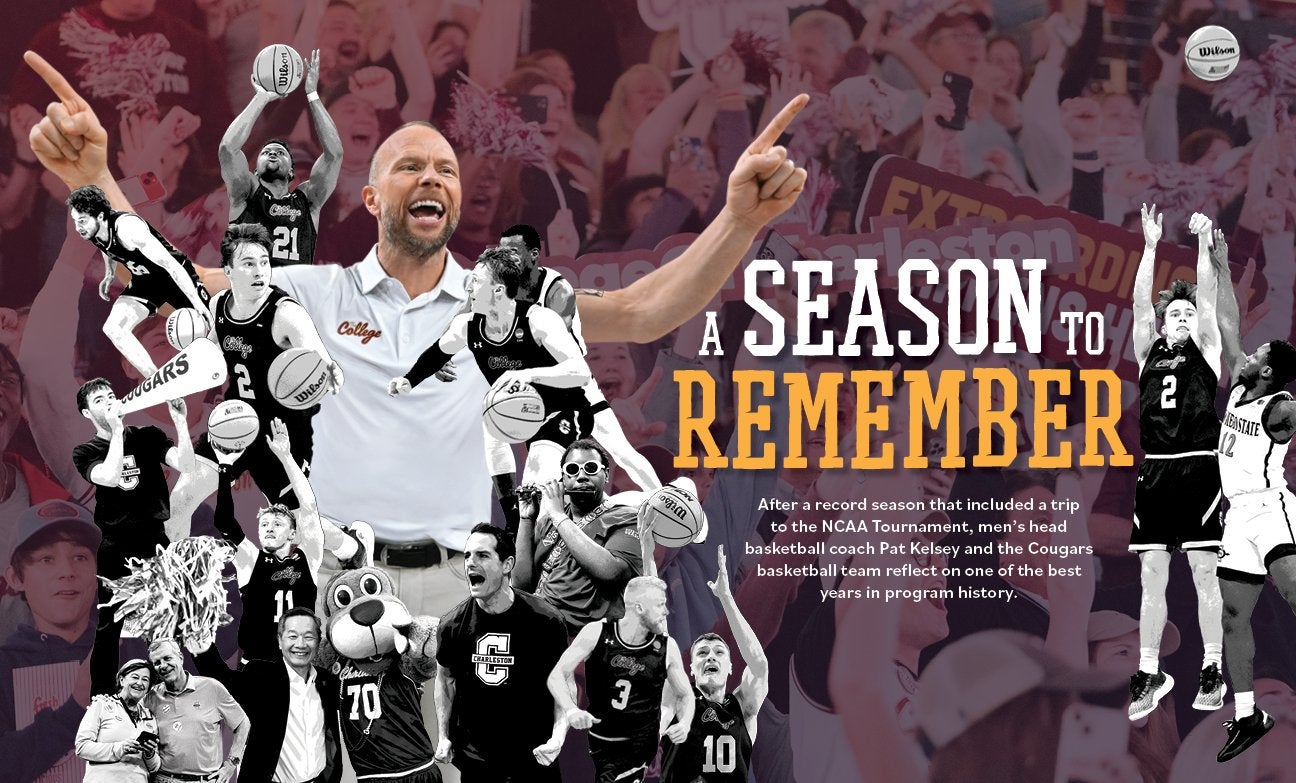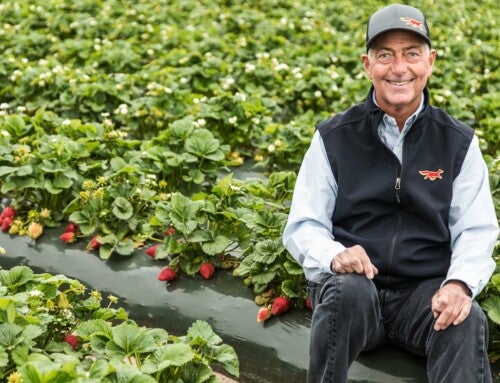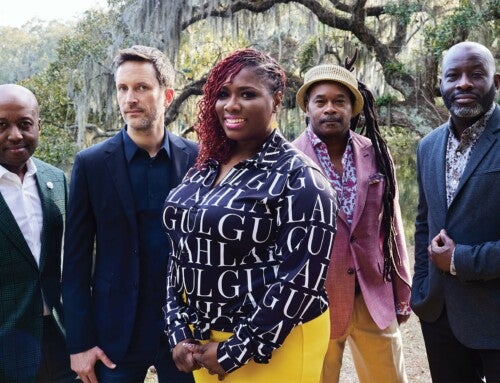There had been pickup games at TD Arena and workouts and team meetings for most of the summer.
The bond between teammates that had begun to form in early June of 2022 had been cured and settled like hardened cement by the time classes started in mid-August.
Strangers had to quickly become friends. Friends had to turn into family.
That familial connection between the new teammates, managers and coaching staff was acute by the time the College of Charleston men’s basketball team gathered for a cookout at head coach Pat Kelsey’s Daniel Island home in early September. The collection of individuals with egos and agendas just a few months prior had become something more – 25 Strong.
The players on the College’s 2022–23 men’s basketball team can recite the program’s three tenets in their sleep: relentless effort, competitive excellence and power of the unit. The Cougars were the personification of all three during a historic basketball season. And the sum was greater than the individual parts. 
Ryan Larson, a graduate transfer student from Wofford College, could sense the team’s promise from that meeting at Kelsey’s house – playing wiffle ball in the backyard with the coach’s 10-year-old son, Johnny, affectionately known to the players and his dad as “Johnny Ballgame.”
“The togetherness we showed on Day One was special,” says Larson, who completed his MBA at the College this spring.
Larson knew a thing or two about being part of a “special” team and could see the familiar signs. In 2019, during Larson’s freshman year at Wofford, the Terriers had gone 30-5, steamrolling their way through the Southern Conference, and won a game in the NCAA Tournament for the first time in the program’s history.
“That Wofford team was one of the most special and connected teams I have ever been a part of,” says Larson. “This team was just like that. I could just tell from Day One that this team would vibe together. I’ll never forget this season with these guys. I know I’ve made friends here that I’ll have for the rest of my life.”
The College’s 2022–23 team will go down as one of the most successful in program history. In his second year at the helm, Kelsey molded this unusual collection of players into a championship team.
Here is the list of accomplishments during the Cougars’ historic run:
- Most wins (31) in school history at the Division I level
- First mid-major program to win ESPN’s Charleston Classic
- Nation’s longest winning streak at 20 games
- Monthlong appearance in the AP Top 25 poll for the first time in two decades
- Nine straight sellouts at TD Arena
- CAA regular-season and tournament champions
- NCAA Tournament appearance (the team they lost to in a close battle in the first round, San Diego State, went to the Final Four)
“This was a special group, an elite group,” says Kelsey. “They were elite in their consistency. There was an uncommon commitment among everyone on this team to the guy next to him. It was the power of the unit – 25 Strong. They unselfishly gave of themselves for the good of the whole. We had a roster full of guys that did that for us all season.” 
‘Island of Misfit Toys’
Kelsey and his coaching staff didn’t build the Cougars’ roster by traditional methods. Even in this age of name, image and likeness endorsements and the transfer portal, where players seemingly leave a program as often as they change their socks, Kelsey took an unconventional approach to assembling the team.
The core of the team was not built with five-star high school talent or even Division I transfers – Larson being the one exception. Dalton Bolon, Pat Robinson III and Ante Brzovic all transferred from Division II schools, while Jaylon Scott was an All-American at the NAIA level.
They all, however, had a common origin story. Bolon, Robinson, Brzovic and Scott did not receive a single Division I scholarship offer coming out of high school. Bolon was a walk-on at Division II West Liberty University, and Robinson had to sleep on a friend’s couch in Philadelphia during his first season at the collegiate level. Brzovic’s friends and teammates in Croatia thought the skinny, 6-foot-10 forward would wash out in the United States, and Scott barely averaged a basket a game in high school.
They were all dismissed as Division I prospects coming out of high school, and it’s that common thread that fuels them on the court.
“I’ve heard us called the ‘Island of Misfit Toys,’” says Bolon with a chuckle. “Instead of getting mad about it, I think we all kind of leaned into it, embraced it. I think it’s why we play the way we do when we’re on the court. We play with a chip on our shoulders because we feel like we’ve got something to prove.”
It’s also what gives a player like Robinson the confidence to take the game-winning shot against defending ACC Tournament champion Virginia Tech in the Charleston Classic.
“I knew I had to work harder to get to where I am,” says Robinson. “It’s one of the reasons I try to play harder than anyone else on the floor.”
And, like the misfit toys in the classic Christmas TV special Rudolph the Red-Nosed Reindeer, Bolon, Robinson, Scott and Brzovic found a home where they could thrive.
It’s no coincidence that Kelsey has mined the Division II level for talent over the years. Kelsey’s younger brother, Walt, and his sister, Katie, both played at Northern Kentucky, just across the Ohio River from his Cincinnati home, when the Norse were a perennial Division II powerhouse. Kelsey spent hours on the Northern Kentucky campus playing in pickup games against the Norse players and had a healthy respect for their skills.
“There are a lot of great players in Division II,” says Kelsey. “A lot of times, the only difference between a Division I and Division II player is a scholarship. It just takes one coach to believe that you can play at that level.”

Pat Kelsey strategizes with the team during the CAA
Championship game against UNCW. (Photo by Maxwell Vittorio)
‘Gonzaga of the East’
The Cougars’ success on the basketball court this season is just the first step toward a greater goal.
When College of Charleston President Andrew T. Hsu met with Kelsey during the coach’s job interview in 2021, the president had a vision for the program.
“I told coach Kelsey that we wanted to be the Gonzaga of the East,” recalls Hsu. “I think we have an opportunity to get there. This is just the beginning.”
Gonzaga, a small, private Jesuit school in Spokane, Washington, has been to 23 consecutive NCAA Tournaments, with four Elite Eight appearances and two Final Fours. Many mid-major schools have tried to replicate the Zags’ success, but few have succeeded. “Basketball is one of those unique sports where you can turn a mid-major program into a major program, and that’s our goal,” says Matt Roberts, director of athletics at the College. “With the right coach and the right continuity and consistency from the administration and Board of Trustees, it has proven it can be done.”
One of the keys for Gonzaga was the ability to keep head coach Mark Few for more than two decades. Kelsey is already a hot commodity and has been linked to jobs at bigger Power 5 schools.
“I want coaches that are coveted by other schools,” says Roberts. “It means you are hiring the right people.”
Keeping Kelsey around should be easier now that the College’s Board of Trustees approved a five-year, $5.5 million contract extension in March. Kelsey’s contract includes a base salary of $600,000 and an annual supplement of $500,000 from private donors.
The success on the court has also spilled over to the College as a whole, with fundraising for the school expected to reach record levels this year.
“The campus has rallied around the College of Charleston’s brand,” says Hsu. “We’ve had three record years of fundraising, and we are projecting this year to be even better.”
The College and its basketball program received a tsunami-sized wave of publicity during the 2022–23 basketball season. According to the College’s media-monitoring software, the ad-equivalency for media coverage related to College of Charleston basketball from Jan. 2 – when the Cougars were first ranked in the AP’s Top 25 – to the NCAA Tournament in mid-March, was more than $66 million.
“That’s exposure for the university and the basketball program that you can’t buy,” says Roberts.
And it garnered a lot of good will and undoubtedly contributed to a record number of student applications.
“The whole community has embraced the basketball team,” says Hsu. “We will be able to recruit better students because of the success of the basketball team. It is a positive feedback loop that will continue to feed on each other.” 
Elite Recruiting Class
Capitalizing on the momentum generated from a conference championship and an NCAA Tournament run is one the keys to sustained success. That begins with signing an elite recruiting class.
Kelsey and his coaching staff were able to land two highly regarded high school players in December – four-star forward Mayar Wol and three-star forward/center James Scott. The two prep players are part of what is considered one of the top recruiting classes in school history. Several analysts have the class ranked as one of the top mid-major classes in the country for 2023.
“With an ultra-versatile hybrid forward on both ends of the floor and a rapidly ascending big man with all the tools to be a major sleeper, Charleston has what now rates as a historically good recruiting class in the CAA,” said 24/7 recruiting analyst Adam Finkelstein.
The Cougars signed 6-5 shooting guard Bryce Butler, a Division II All-American from West Liberty University, where Bolon and Robinson played. Kelsey was also able to get point guard Kobe Rodgers, who played two seasons at Nova Southeastern in Florida, starting every contest on the way to a 36-0 season and the Division II national title. Rodgers and Butler played against each other in the Division II national championship game. Stony Brook graduate transfer Frankie Policelli, who led the CAA in rebounding, and guard CJ Fulton from Lafayette College in Easton, Pennsylvania, round out the class.
“The players we bring in have to have certain floor metrics,” says Kelsey. “They have to be competitive; they have to be tough; they have to have a high basketball IQ; and they have to make people around them better. There are very few elite players. We want to be the top 1% of the elite. Our goal every single day is to operate like we are the best program in the country.”



